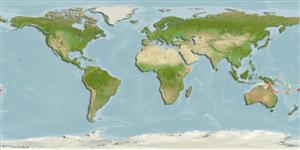>
Gobiiformes (Gobies) >
Gobiidae (Gobies) > Gobiinae
Etymology: Grallenia: Named for Gerald R. Allen, (G+R+Allen+suffix '-ia'), in honor of his great contribution to our knowledge of the diversity of coral-reef fishes; lauensis: Named for its type locality, Lau Archipelago.
Eponymy: Dr Gerald Ray Allen (d: 1942) The genus was named to honour “…his great contribution to our knowledge of the diversity of coral-reef fishes.” (See Allen, GR) (Ref. 128868), visit book page.
Environment: milieu / climate zone / depth range / distribution range
Ecologie
marien rifbewoner; diepte 30 - 35 m (Ref. 116128). Tropical
Western Pacific: Fiji and Australia (Great Barrier Reef and northwestern Coral Sea).
Grootte / Gewicht / Leeftijd
Maturity: Lm ? range ? - ? cm
Max length : 1.6 cm SL mannelijk / geslacht onbekend; (Ref. 116128); 1.1 cm SL (female)
Korte beschrijving
Determinatiesleutels | Morfologie | Morfometrie
Dorsale stekels (totaal) : 7; Dorsale zachte stralen (totaal) : 7; Anale stekels: 1; Anale zachte stralen: 7; Wervels: 27. This species is distinguished by the following characters: D VI + I,7; A I,7; all segmented dorsal- and anal-fin rays are unbranched; pectoral-fin rays 15, all rays unbranched except the middle 2-4; posterior longitudinal scales 8-12, mainly restricted to caudal peduncle; no scales on anterior body; body depth at pelvic-fin origin 15.1-15.7% SL; depth at anal-fin origin 12.9-13.2% SL; with cephalic sensory-canal pores; live colour of female mainly translucent with faint markings, including 5, progressively shorter, orange-brown, dash-like marks overlying vertebral column, about 10-12 narrow orange bars on the back between level of pectoral-fin base and caudal-fin base, and 5-6 widely-spaced, brown-to-orange spots on lower side between middle of abdomen and caudal-fin base; male colour unknown (Ref. 116128).
Inhabits area of extensive gradual slopes of clean white sand (in 30-35 m depth). Collected from sites located in channel passes from the outer reef to extensive inner lagoons, and were hence subject to frequent strong currents and high rates of water exchange (Ref. 116128).
Levenscyclus en paargedrag
Maturiteit | Voortplanting | Paaien | Eieren | Fecunditeit | Larven
Allen, G.R. and M.V. Erdmann, 2017. Descriptions of five new species of marine gobies (Teleostei: Gobiidae) of the genus Grallenia) from the tropical western Pacific Ocean. J. Ocean Sci. Found. 27:20-47. (Ref. 116128)
Status op de Rode Lijst van het IUCN (Ref. 130435: Version 2024-2)
Gevaar voor de mens
Harmless
Gebruik door de mens
Tools
Speciale rapporten
Download XML
Internetbronnen
Estimates based on models
Fylogenetische diversiteitsindex (Ref.
82804): PD
50 = 0.5039 [Uniqueness, from 0.5 = low to 2.0 = high].
Bayesian length-weight: a=0.00724 (0.00339 - 0.01546), b=3.10 (2.92 - 3.28), in cm total length, based on LWR estimates for this (Sub)family-body shape (Ref.
93245).
Trofisch niveau (Ref.
69278): 3.0 ±0.3 se; based on size and trophs of closest relatives
Weerstandsvermogen (Ref.
120179): Hoog, minimale populatieverdubbelingstijd minder dan 15 maanden (Preliminary K or Fecundity.).
Fishing Vulnerability (Ref.
59153): Low vulnerability (10 of 100).
